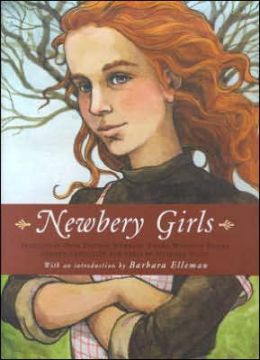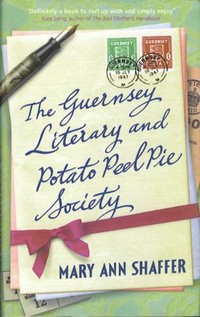The wonderful teacher-turned-librarian-turned-author Esme Raji Codell wrote a post on her blog that I think is worth sharing... along with some new books I want (Especially Promises to Keep, about Jackie Robinson written by his daughter Sharon!)
[Original post here]
So, in the usual spirit of borderline political incorrectness, I challenge us to a Somebody Else Summer. Just think: if you were to share just one children's book biography a week, by the end of the season your child will have been introduced to at least ten amazing figures in history: artists, politicians, athletes, scientists, peacemakers. So, culled from the PlanetEsme archives plus one new book-of-the-day, I offer you a baker's dozen to get you started, in the hopes that come fall, when a teacher asks, "does anyone have any heroes or any idea what they would like to be when they grow up?" Your child can raise a hand and shout, "ME!"
 BOTTLE HOUSES: THE CREATIVE WORLD OF GRANDMA PRISBEY by Melissa Eskridge Slaymaker, illustrated by Julie Paschkis (Henry Holt)
BOTTLE HOUSES: THE CREATIVE WORLD OF GRANDMA PRISBEY by Melissa Eskridge Slaymaker, illustrated by Julie Paschkis (Henry Holt)Grandma Prisbey needed a place to keep her pencil collection, her doll collection, and herself! So she drove down to the dump to find materials for a house, and what she found was bottles of all shapes and sizes. Using these materials, she built a little spot of heaven, complete with wishing well, singing tree, and pyramid. Colorful and folksy illustrations accentuate this inspiring true story of a woman who was able to build a wonderful world using what was available to her, and photographs at the end will leave readers with eyes as big as bottle-bottoms. The spirit of independence shines through every page like colored glass, and the text is full of gems from Grandma Prisbey herself: "What some people throw away I believe I could wear to church," and "They call me an artist even though I can't draw a car that looks like one. But I guess there are different kinds of art." I guess so, Grandma…and this book qualifies! (6 and up)
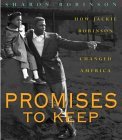 PROMISES TO KEEP: HOW JACKIE ROBINSON CHANGED AMERICA by Sharon Robinson(Scholastic)
PROMISES TO KEEP: HOW JACKIE ROBINSON CHANGED AMERICA by Sharon Robinson(Scholastic)The daughter of the man who intregrated Major League Baseball has given America a beautiful gift in the form of an annotated scrapbook. From his early days as a WWII soldier who was arrested for refusing to ride at the back of an army bus to his rise as a to his leadership as an community businessman, raising money for the Civil Rights Movement by sponsoring jazz concerts, this book has many surprising and always impressive details about this man who was a champion on and off the field. Sharon Robinson's conversational, unassuming tone takes on a family confidence, culminating in her own personal wish for a global society. This book will, as her father's life did, contribute to that goal. A home run of a biography. (9 and up)
 STRANGE MR. SATIE by M.T. Anderson, illustrated by Petra Mathers (Viking)
STRANGE MR. SATIE by M.T. Anderson, illustrated by Petra Mathers (Viking)I asked my husband, an artist, what he thought of this book, and he said, "If I had read this book as a kid, it would have changed the way I thought life could be." Composer Erik Satie did indeed put the en garde in the avante garde, hanging out with Picasso, tossing his girlfriend out of a window (luckily, she was a circus performer and landed safely), wearing seven identical grey velvet suits, playing jazz on typewriters, producing ballets that required live camels and cannons firing, and fathering the movement known as surrealism. This is a man who, instead of writing instructions in his music like fast, loud or slowly, gave directions like "from the end of the eyes" and "I want a hat of solid mahogany." I don't know if everyone would want Mr. Satie as a friend after reading this book, but he sure was a colorful character, and this comes through very clearly thanks to the affectionate and sympathetic treatment by both author and illustrator. This is a very accessible children's book about a complicated eccentric, in part because of the understated, imaginative artwork that arranges the chaos (look at the drawing of Satie's ideas playing out, quite literally, across stanzas of music) and gorgeous, succinct writing that reads like musical notes; the last page of this book may be the best I have ever read in children's biography. A book that deserves the rave reviews and acceptance that eluded Satie in his lifetime. (6 and up)
 SHOLOM'S
TREASURE: HOW SHOLOM ALEICHEM BECAME A WRITER by Erica Silverman,
illustrated by Mordicai Gerstein (Farrar Straus Giroux)
SHOLOM'S
TREASURE: HOW SHOLOM ALEICHEM BECAME A WRITER by Erica Silverman,
illustrated by Mordicai Gerstein (Farrar Straus Giroux)Little Sholom's life is no picnic, shivering while he studies in the crowded, icy kheyder, abandoning plans of lucrative treasure-hunting when his best friend moves away, and the slings and arrows of a short-tempered, sharp-tongued stepmother are almost more than the unfortunate fellow can bear. Luckily, his ability to notice and imitate the idiosynchrocies of those around him is a source of laughter and light, and allows Sholom to stand out first in his home, and then for the whole wide world to see. This realistic and compelling story of the boyhood of the author of the short stories that would someday inspire Fiddler on the Roof does a dandy job of recreating the life and struggles of the shtetl, and Gerstein's busy frames further bring the vignettes into focus. Literary legacy aside, though, this biography successfully brings to life a very real little boy who likes to make people laugh and maybe gets into a little bit of trouble here and there. Know any little boys like that? (7 and up)
 HARVESTING HOPE by Kathleen Krull, illustrated by Yuyi Morales (Harcourt)
HARVESTING HOPE by Kathleen Krull, illustrated by Yuyi Morales (Harcourt)On a ranch in the Arizona desert was a family thriving on eighty acres, until the great drought drove them all to migrant work. Though their crops may have withered, a seed was germinating in young Cesar Chavez. The indignities he experienced as a shy Spanish-speaking student and the grueling conditions are honestly portayed. Children will be stirred by these indignities, and their hearts equally swelled by the huelga, Chavez's peaceful movement against threatening overlords. His three-hundred mile march from Delano to Sacramento was the longest in U.S. history, and resulted in the first ever contract for farmworkers. This is an extremely powerful book that underscores the bravery and resolve it takes to engage in non-violent protest, and rightly puts Chavez on the same scaffolding as Martin Luther King as a champion of civil rights. The lush illustrations roll across double-pages horizontally set, thoughtfully designed as to emphasize distance: how far the people had to travel both spiritually and physically to achieve the goal. A page-turning read-aloud about an important chapter of Latino history, this is a welcome and well done contribution to the shelves of children's biography. Viva la Causa! (7 and up) Oh, and just look at Kathleen Krull visiting the PlanetEsme Bookroom to share another one of her must-reads,A WOMAN FOR PRESIDENT: THE STORY OF VICTORIA WOODHILL (Walker)! She has many outstanding biographies available, and may I say, what a cutie! Kathleen Krull for president!

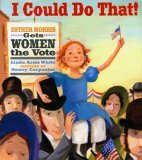 I COULD DO THAT!: ESTHER MORRIS GETS WOMEN THE VOTE
I COULD DO THAT!: ESTHER MORRIS GETS WOMEN THE VOTEby Linda Arms White, illustrated by Nancy Carpenter (Farrar Straus Giroux)From an early age, independent and confident Esther McQuigg has been saying "I can do that." When her mother dies and the family is left to take care of one another, she says "I can do that." When she turns nineteen and it occurs to her to run her own millinery shop, she thinks, "I can do that." She can attend an abolitionist church, she can try to claim land in Illinois, she can raise her son Archy on her own, and she can move to the wild, wild western Wyoming territory. And finally, when it is time to vote in the first territorial elections, why, Esther takes out her trusty teapot and uses her influence to finagle a way she can do that, too. This picture book biography voices tells the true story of a spunky suffragette who became the first female judge, and the first woman in the United States to hold a political office, and the woman who influenced legislature that allowed women in her territory to be able to vote. Homey, wry colored-chalk illustrations are a perfect match to the text; the montage of women receiving the news of their hard-won right springs off of the page. This book is a jubilant celebration of what a can-do attitude can achieve. Tea-pot endpapers also serve as a timeline of the achievement of women's rights throughout the frontier territories. "There are still some countries where women's voices are not heard," the author's note points out. Can this be fixed? I have a feeling some little girl will read those words and think, "I can do that." (7 and up)
 MACK MADE MOVIES by Don Brown (Roaring Brook)The
man who started out playing a horse's rear end rises to becoming a
studio head in this true story of the turn of the century filmmaking
legend Mack Sennett, who brought us Charlie Chaplin, W.C. Fields, the
Keystone Cops and the very first pie in the face. Mack worked so hard
that his hair turned white, and sometimes oversaw his slapstick crew
from a bathtub in a tower in the middle of the movie lot. Understated
sepia-toned watercolors capture the tone of a simpler time. With this
tribute to a man who had "reel" faith in the funny, Brown has made yet
another exceptional contribution to the shelves of children's biography.
Be sure to follow with a showing of a silent movie like The Gold Rush (try to get one without narration and with piano accompaniment featuring Chaplin's score to get an authentic old-time feel).
MACK MADE MOVIES by Don Brown (Roaring Brook)The
man who started out playing a horse's rear end rises to becoming a
studio head in this true story of the turn of the century filmmaking
legend Mack Sennett, who brought us Charlie Chaplin, W.C. Fields, the
Keystone Cops and the very first pie in the face. Mack worked so hard
that his hair turned white, and sometimes oversaw his slapstick crew
from a bathtub in a tower in the middle of the movie lot. Understated
sepia-toned watercolors capture the tone of a simpler time. With this
tribute to a man who had "reel" faith in the funny, Brown has made yet
another exceptional contribution to the shelves of children's biography.
Be sure to follow with a showing of a silent movie like The Gold Rush (try to get one without narration and with piano accompaniment featuring Chaplin's score to get an authentic old-time feel).On a personal note...
I consider Don Brown to be one of the most outstanding biographers for children around today. Like Kathleen Krull, he always picks intruiging people that you will be glad to know about, and every single one of his works reads aloud like butter. KID BLINK BEATS THE WORLD, ODD BOY OUT: YOUNG ALBERT EINSTEIN and FAR BEYOND THE GARDEN GATE: ALEXANDRA DAVID-NEEL'S JOURNEY TO LHASA are a few of my favorites, but there are many more. Honestly, even if you read nothing but Don Brown books for your Somebody Else Summer, you'd be in good shape. (7 and up)
 THEODORE ROOSEVELT: CHAMPION OF THE AMERICAN SPIRIT by Betsy Harvey Kraft (Clarion)
THEODORE ROOSEVELT: CHAMPION OF THE AMERICAN SPIRIT by Betsy Harvey Kraft (Clarion)Teddy Roosevelt is often remembered in history books as the wild "Rough Rider" of the Spanish-American War, and that is why this book is so necessary; this is one president that was so much more, the one that exclaimed "No one has ever enjoyed life more than I have." This book suggests that there may be some truth to that statement! In his lifetime, Roosevelt bravely busted trusts, introduced reforms to the meat-packing and railway industries, was outspoken about the equality of women, led the building of the Panama Canal and was an impressive preservationist introduced legislation that still protects our natural resources today. During a speech while seeking presidential election, he was shot, and with the bullet in his body insisted on speaking for an hour and a half before being taken to the hospital. Well into his fifties, he decided to take advantage of "my last chance to be a boy" and plunged into an adventure exploring the Brazilian River of Doubt, kept company by the likes of Vampire bats, pirhanas and flesh-eating ants. His efforts in cartography led the river to be renamed the Rio Roosevelt. Despite his well-earned reputation as a rather raunchy and hard-boiled figure, was the first president to receive a Nobel Peace Prize. Children will especially revel in his accomplishments as he rises from a shy, asthmatic boy to popular president and adventurer. Excerpts from letters, archival photographs, a timeline and bibliography including websites and videos round out this fully realized portrait of a real American hero. It is safe to say there has never been anyone before or since quite like Teddy Roosevelt, though this book will surely inspire admiration and emulation of some of his spirited qualities in readers. I can't help but imagine that if he came across this handsome tribute today, he'd think it was very bully indeed. (10 and up)
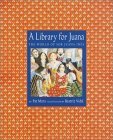 A LIBRARY FOR JUANA by Pat Mora, illustrated by Beatriz Vidal (Knopf)
A LIBRARY FOR JUANA by Pat Mora, illustrated by Beatriz Vidal (Knopf)This exquisite volume pays homage to the great poet of the seventeenth century and one of the greatest booklovers of all time. While children today still recite her poetry throughout the Spanish-speaking world and her face appears on Mexican currency, many North American girls will find a new and worthy heroine between these bindings. Juana Inéez is a child prodigy, her thirst for knowledge so great that she follows her sister to school when she is three years old and learns to read. So begins an unusual childhood for her time; though girls were not permitted at university, at ten years old she went to Mexico City where she was privately tutored, ultimately becoming a lady-in-waiting at the viceroy's palace and wowing the court and an assemblage of forty scholars. She ultimately left the palace and became a nun so that she could concentrate on her pursuit of knowledge and create one of the largest libraries in all of the Americas, and one glorious day, her own book of poetry would be added to those shelves. Children will be inspired by her cheerfulness and insistent spirit, and intruiged by how someone so long ago could have had such modern sensibilities. Nearly every page is graced with borders of delicate fruit and flowers, and the illustrations are crisp and elegant, painted using small brushes under a magnifying glass. A jewel of a book about a jewel of a woman. (6 and up)
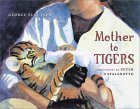 MOTHER TO TIGERS by George Ella Lyon, illustrated by Peter Catalanotto
MOTHER TO TIGERS by George Ella Lyon, illustrated by Peter Catalanotto (Farrar Straus Giroux)
Helen Delaney Martini had three babies...baby tigers, that is! When her husband, a zookeeper at the Bronx zoo brought home animals that needed special care, they thrived under Helen's loving touch. When the tigers grew up, she realized there would always be zoo babies who needed nurturing, and started the first zoo nursery! "Before Helen arrived, no tiger born at the zoo ever survived. She raised twenty seven." So the next time you visit the big cats in the zoo, just think, that they may be grandcubs of Helen's wards! This compelling picture book biography of the Bronx's zoo's first woman zookeeper will touch the heart of any animal lover, and is accented with dramatic illustrations in torn paper panels. (7 and up)
 THE ADVENTUROUS CHEF ALEXIS SOYER by Ann Arnold (Farrar Straus Giroux)
THE ADVENTUROUS CHEF ALEXIS SOYER by Ann Arnold (Farrar Straus Giroux)Ze special tonight is ze culinary delight Alexis Soyer, ze king of ze kitchen, ze man who revolutionized what a kitchen can do for ze world, don't you see! Oh, you don't? Then you must read this picture book biography which follows Soyer from a rakish cooking school student to the celebrated chef of Europe's artistocracy, to the savior/foodie during the Irish potato famine and the Crimean War. Faithful to French fashion, there is a love story baked in, but what really carmelizes this book are all the interesting advances Soyer suggested, making him a notable inventor and humanitarian as well as a great chef. There are things in all of our kitchens that we can attribute to Soyer's innovations, read and find out what they are! Yes, the pen and ink with watercolor illustrations are yummy: detailed and delicate. The map of Soyer's dream kitchen is captivating to explore. This is a noble story of an epicurean life, and one that will inspire children who are destined to make unconventional contributions. (8 and up)
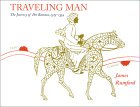 TRAVELING MAN: THE JOURNEY OF IBN BATTUTA, 1325-1354 by James Rumford (Houghton Mifflin)
TRAVELING MAN: THE JOURNEY OF IBN BATTUTA, 1325-1354 by James Rumford (Houghton Mifflin)Told in first person voice, here is the story of Ibn Battu, the great traveler of his age, covering over seventy five thousand miles. Yes, seventy-five thousand! Across Morocco, China, Russia, Tanzania, and all during a time when people still believe the world was flat. Sound daunting? Not to Battuta; he advised a child who said "I wish I could go where you went, see what you saw," that "You can...all you do is take the first step." I opened this book up to a double-page spread of a camel caravan trudging through the Hindu Killing Mountains, and it took my breath away as sure as a blast of cold air from their snowy peaks. Besides stunning illustrations, beautiful Arabic lettering (which the author learned by studying from a master calligrapher in Afghanistan) and ancient Arab maps, this book shows a gamut of one man's struggles, emotions, faith and imagination. And to top it off, the book is still accessible enough to share with the whole family or classroom. Besides meeting all the criteria for a four-star picture book, it also includes excellent maps and a glossary. Battu's treasures were his travels, and you will treasure this reading trip as well. (7 and up)
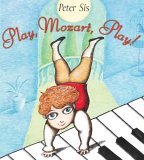 And didn't a promise you a new book a day? Here is Peter Sis's latest,
And didn't a promise you a new book a day? Here is Peter Sis's latest,PLAY, MOZART, PLAY (Greenwillow), a portrait of the artist as a very young man, and as usual Sis's pictures are worth a thousand words; surreal and playful scenes of Mozart's imaginative life sparkle against the background of his oppressive and overseeing father, depicted as a shadow. Young Mozart's visions cheerfully overtake any hints of darkness, though; this is the strength of art, the strength of children, and the resonant strength of this book. (5 and up)










